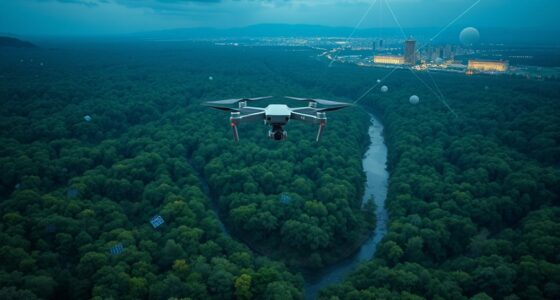Geoengineering could be a quick way to tackle climate change or risky enough to cause unintended harm. Techniques like injecting aerosols into the atmosphere may temporarily cool the planet but might disrupt weather patterns and ecosystems. Carbon capture aims to address root causes but requires massive infrastructure. It’s not a perfect fix, and ethical concerns linger. If you want to explore what science says about whether geoengineering is a gamble or a solution, keep looking deeper.
Key Takeaways
- Geoengineering involves manipulating Earth’s systems, such as reflecting sunlight or capturing CO₂, to combat climate change.
- Solar radiation management can temporarily cool the planet but risks disrupting weather patterns and ecosystems.
- Carbon capture targets reducing greenhouse gases but requires large-scale infrastructure and energy, with uncertain long-term impacts.
- These methods are complex, uncertain, and often viewed as short-term solutions rather than permanent fixes.
- Ethical concerns and potential unintended consequences make geoengineering a controversial, high-stakes approach.

As climate change accelerates, geoengineering emerges as a controversial yet compelling solution that could potentially slow or reverse global warming. Imagine techniques that manipulate Earth’s systems directly, aiming to reduce the planet’s temperature or remove excess greenhouse gases. One approach involves reflecting solar radiation back into space, effectively dimming the sunlight that warms our planet. This method, often called solar radiation management, might involve dispersing aerosols into the stratosphere to create a temporary cooling effect. The idea is to buy time as we work on reducing emissions, but it’s not without risks. If sunlight is blocked unevenly, it could disturb weather patterns or cause unforeseen environmental consequences.
Geoengineering offers quick fixes like solar radiation management but risks disrupting climate and ecosystems.
Alongside solar radiation techniques, carbon capture plays a critical role in geoengineering strategies. You might think of carbon capture as a way to scrub CO₂ directly from the atmosphere or from emission sources like power plants. This process involves using filters, chemical reactions, or even underground storage to trap greenhouse gases before they can warm the planet further. By combining solar radiation management with robust carbon capture efforts, you could potentially address both the cause and effect of climate change. However, deploying large-scale carbon capture requires significant energy and infrastructure investments, raising questions about its feasibility and long-term sustainability.
As you learn more about geoengineering, you realize that these methods are not simple fixes but complex interventions with uncertain outcomes. Solar radiation techniques might provide quick relief from rising temperatures but could also disrupt rainfall patterns, impacting agriculture and water supplies. Carbon capture, while promising, faces hurdles in scaling up to the levels needed to make a meaningful difference. You might wonder if these solutions are enough or if they merely serve as band-aids while we continue to emit greenhouse gases at alarming rates. Additionally, the development and deployment of advanced monitoring technologies are crucial to track the environmental impacts of geoengineering efforts in real time.
The debate about geoengineering revolves around weighing potential benefits against risks. Some experts see it as a necessary emergency measure, a way to buy time while transitioning to renewable energy sources. Others warn that it could lead to unintended consequences or even moral hazard, where reliance on technological fixes discourages efforts to cut emissions. As someone interested in the future of our planet, you must consider both the scientific possibilities and the ethical dilemmas involved. While geoengineering might not be a perfect or permanent answer, understanding its potential and limitations is essential as we navigate the urgent challenge of climate change.
Frequently Asked Questions
What Are the Long-Term Environmental Impacts of Geoengineering?
You might wonder about the long-term environmental impacts of geoengineering, considering environmental risks and technological feasibility. While it could help mitigate climate change, you should also think about potential unintended consequences like disrupting ecosystems or altering weather patterns. The environmental risks remain uncertain, and the technological feasibility is still being tested. Carefully weighing these factors can help you decide whether geoengineering is a viable long-term solution or a risky gamble.
Who Controls and Regulates Geoengineering Projects Worldwide?
Imagine a world where geoengineering projects run unchecked—sounds risky, right? You should know that international oversight and regulatory challenges make controlling these projects tricky. No single entity governs them; instead, global organizations and governments share responsibility. This fragmented oversight often leads to gaps and conflicts, raising questions about safety and ethics. Ultimately, strong international cooperation is essential to guarantee responsible geoengineering that benefits everyone, not just a few.
Can Geoengineering Be Reversed if Unintended Consequences Occur?
You might wonder if geoengineering can be reversed if unintended consequences arise. Technological feasibility varies; some methods, like injecting aerosols, could be halted, but others may have lingering effects. Economic implications also matter—reversing large-scale interventions could be costly and complex. While some techniques are designed for reversibility, uncertainties remain, so it’s essential to weigh potential risks and benefits carefully before deploying any geoengineering solutions.
How Does Geoengineering Affect Global Weather Patterns?
You might wonder how geoengineering impacts global weather patterns. It can alter solar radiation levels by reflecting sunlight back into space, which can cool the planet but might also disrupt natural climate systems. Cloud seeding, a common method, encourages rainfall but can unintentionally change regional weather. These interventions can lead to unpredictable shifts in weather patterns worldwide, making it essential to weigh potential benefits against possible environmental risks.
What Ethical Concerns Are Associated With Geoengineering Implementation?
You should consider the ethical concerns of geoengineering, as it involves moral dilemmas about human intervention in nature. You might worry about technological risks, like unintended consequences or unequal impacts on different regions. Implementing geoengineering could raise questions about consent and governance, making it essential to weigh the potential benefits against these moral and safety issues before proceeding. Your decision impacts both current and future generations.
Conclusion
Think of geoengineering as a double-edged sword—a flickering lighthouse guiding us through stormy waters or a wildfire threatening to consume everything. It’s a symbol of hope, shining brightly on a troubled horizon, but also a reminder of the risks lurking in the shadows. As you stand at this crossroads, remember that your choices today shape the planet’s future—act wisely, for the Earth’s delicate balance depends on your hand in the darkness.









